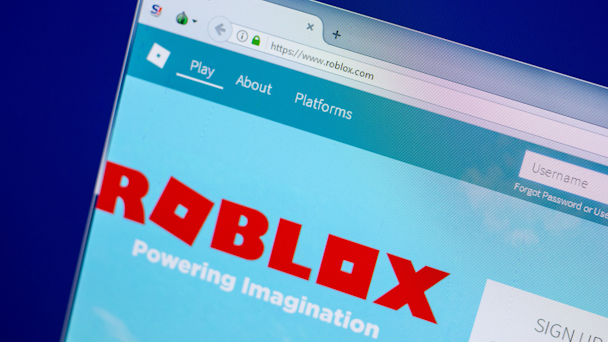Does the metaverse still hold promise for retail brands?
Some experts believe that the best is yet to come from this ever-evolving and often misunderstood virtual space. We take a look as part of The Drum’s latest Deep Dive, The New Retail Landscape.

Roblox reported 70.2 million average daily active users in the third quarter of 2023 / Adobe Stock
Most marketers will remember a time not so very long ago when the metaverse seemed destined to be the next big thing for their industry.
Like moths to a flame, brands were rushing into virtual reality (VR) and popular online gaming platforms like Roblox and Fortnite, eager to establish a firm foothold in what was widely billed at the time as the marketplace of the future.
Advertisement
For a time, excitement about the metaverse became a borderline cultural obsession. Books about the metaverse were being published at a rapid clip; advertising conferences like Cannes Lions and Advertising Week New York were flush with conversations about the future of marketing in the metaverse; a futuristic depiction of this virtual space was plastered to the front of Time Magazine, beneath the headline: “Into the metaverse: the next digital era will change everything.” Meta CEO Mark Zuckerberg – who changed the name of his company a little over two years ago to signal its reorientation around the metaverse – confidently proclaimed his belief that virtual experiences represent “the next chapter for the internet.”
To many, that brief period of clamorous excitement about the metaverse might feel like the foggy memory of a dream. Things have changed quickly; only rarely does one encounter a headline announcing that a big-name brand has invested large sums of money in a VR-based experience. Moreover, the stunningly rapid ascension of AI into mainstream consciousness seems to have largely eclipsed public interest in the metaverse (which remains a fuzzy concept that lacks a single, universally agreed-upon definition).
All of this might leave many marketers with a vague sense of whiplash. After so many brands had invested such vast amounts of time, energy and capital into the virtual realm, is it possible that everyone has just forgotten about it and moved on to the next enticing tech trend? Were a few unfortunate PR moments (the collapse of the crypto firm FTX, for example, which produced a widespread distaste for all things associated with the terms ‘decentralized’ and ‘web3,’ and an unflattering virtual selfie shared by Mark Zuckerberg across social media) really enough to poison the entire metaverse well?
Advertisement
Not everyone thinks so. Some marketing experts are confident that, while public excitement about the metaverse has undoubtedly been in a slump over the past year, it’s poised for a major comeback – and that retail brands would do well not to give up hope on this virtual realm.
Separating metaverse myth from reality
Technology evolves in unpredictable and often surprising ways. Take AI, for example. A few decades ago, it was common to believe that intelligent algorithms would quickly lead to embodied robot assistants and self-driving cars, and very few people would’ve said that they were going to push people in creative roles – like graphic designers and music producers – out of the job market. Today, the prodigious rise of large language models (LLMs) has flipped that expectation on its head. We now have models that can compose whole novels in the style of Tupac Shakur or Dostoevsky, but we’re still a long way from ubiquitous autonomous vehicles or housekeeping robots in every home.
Experts are quick to point out that this same principle of uncertain evolution applies to the metaverse – and that just because the initial hype cycle has faded, the original dream of humanity’s virtual future still holds great potential.
“I don’t think [the metaverse is] a lost cause at all,” says Jen Jones, chief marketing officer of Commercetools, a company that helps brands develop e-commerce capabilities. Above all, Jones says she’s noticed a significant shift in the language used to discuss virtual experiences. “Meta taking over the term ‘metaverse’ almost killed the metaverse,” she says. “I don’t think it’s Meta’s metaverse [any more] – everybody’s parked that language a little bit.”
Suggested newsletters for you
So, what are people referring to when they speak of the metaverse these days? In Jones’ view, the concept refers to “the merging of online and offline, of our physical and digital lives … that’s [still] a really hot topic, particularly in retail.”
The metaverse has always held special appeal for retail brands. Perhaps catalyzed by Meta’s name change in late 2021, a slew of major brands – from Walmart to PacSun to Lacoste – began launching virtual experiences that almost always had some kind of commercial component, such as a fitting room where avatars could try on virtual goods that could then be purchased out in the real world. The market for virtual apparel and accessories began to skyrocket as brands realized that young people were beginning to covet such commodities as a new form of personal expression.
Beyond virtual clothing, the metaverse also gives one the freedom to explore new modes of personal identity – there’s no rulebook stating that one’s avatar must resemble one’s physical body. This, says Decentraland’s lead marketer, Kim Currier, is a major reason young people have flocked to virtual environments (with a legion of brands following in tow). “Maybe they identify with a different gender than they are physically; maybe they’re a shy person in the real world, but they love to party in the metaverse. Something about not having to show your face allows you to be a little more free and creative with how you show up every day.”
Currier, a mother of two, says that she is attracted to this quality of freedom and fluidity. “When I’m in the metaverse, I have some really cool neon rave outfit and pink hair,” she says. “I can’t [wear] that regularly, but that would be super fun; I would love to be raving at Coachella to some really fun music, but I probably just put my kids to bed and I’m not leaving my sweatpants.”
Jones, who’s also a mother, says she’s been impressed by the degree to which young kids are excited to spend time on platforms like Roblox. “They’re obsessed with it,” she says. “Boys, girls, artsy kids, math kids, sports kids, they all love it … that’s where they hang out.”
While Meta’s failure to hit its user targets for Horizon Worlds may have dominated the conversation about the metaverse for a spell last year, and while some may have concluded that the metaverse was a rocket that ultimately failed to launch, it can be easy to forget that platforms like Roblox, Decentraland and Fortnite – which many will insist are as much a part of the metaverse as virtual reality – remain strong. Roblox reported last week that its average daily active users stood at approximately 70.2 million in the third quarter of 2023, marking a year-over-year increase of 20%.
“As a brand owner,” says Jones, “you’ve got to think: Who’s your next market? Who are you trying to expand to? For anyone looking at Gen Z and below, this is where they are.”
An inflection point(?)
For now, the metaverse might be primarily populated by kids hanging out and playing games in Roblox. But advances in hardware could soon cause that to change, bringing a much greater swathe of the population into virtual environments.
In June, Apple unveiled its highly anticipated AR/VR headset, the Vision Pro. It has a sleeker form factor than previous headset models, which tended to be blocky and fairly uncomfortable, and it can be controlled without handheld controls – another deviation from the norm. But while its looks might be attractive, its price ($3,499) is likely to repel many potential buyers.
That same month, Meta revealed its Quest 3 headset, which will cost a relatively affordable $499. Zuckerberg described this headset as “the first mainstream mixed reality device,” referring to experiences that blend physical and virtual elements. The Quest 3 hit shelves last month.
Should this new generation of headsets become popular among a mainstream audience, more are sure to follow. Brands, in turn, could then start building experiences around these headsets, just as so many launched their own apps in response to the widespread adoption of smartphones.
Again, technology evolves in unpredictable ways, and no one can yet say definitively what brand experiences in the metaverse will look like one year from now, much less ten years from now. Still, the surge in innovation in the AR/VR headset space has Decentraland’s Currier feeling optimistic about the future. “With all the new tech coming out, we’re excited just to see what will be possible,” she says. “I think 2024 will be a big year for the whole space.”
Commercetools’ Jones encourages brands to maintain a watchful eye on the metaverse, regardless of the fluctuations of the hype cycle. “Technology keeps moving forward,” she says. “Don’t get too overly involved in the bubble, but also don’t get too discouraged by the trough that inevitably follows the bubble … try to keep a pragmatic view, and just keep testing and learning.”
Read more from The Drum’s latest Deep Dive, The New Retail Landscape.

